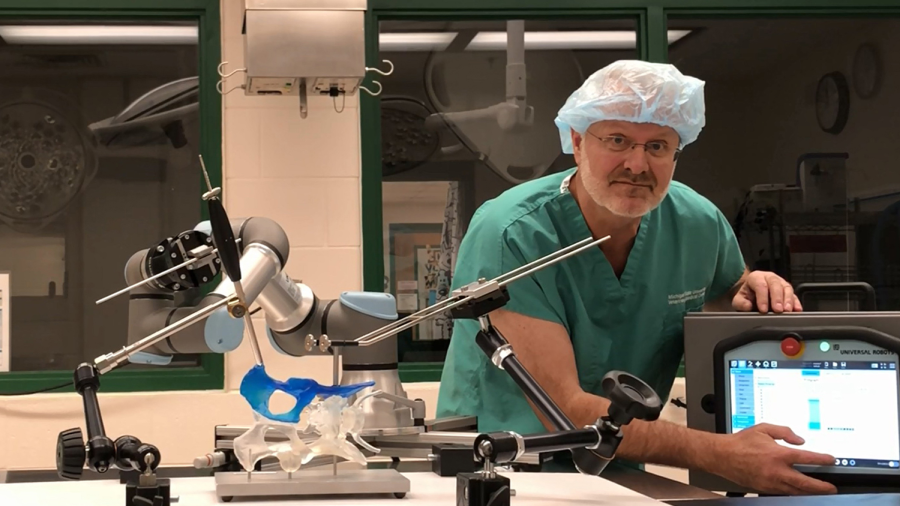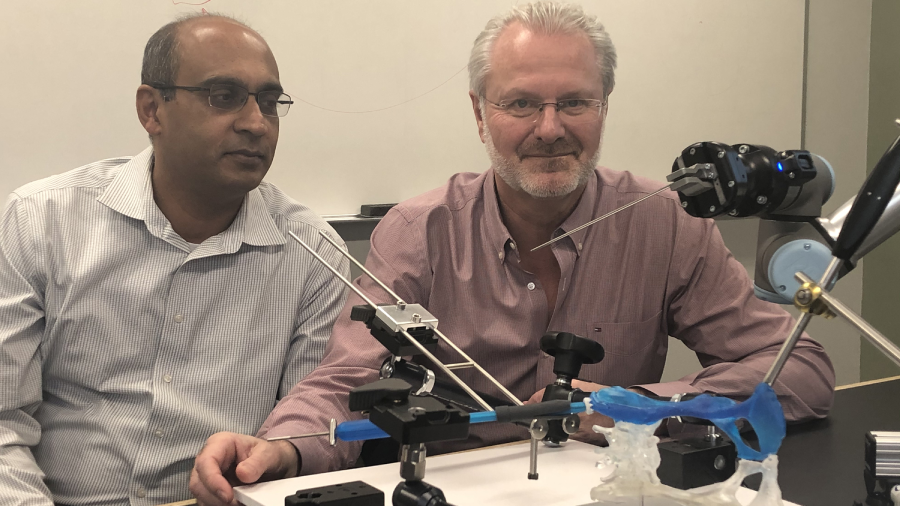A bold vision: New AO project to revolutionize spine and pelvis fracture treatment
AO Innovation Translation Center project uses strategy fund resources to transform patient care

It’s a bold vision, but Michigan State University (MSU) Prof. Loïc Dejardin, DVM, foresees robot-assisted technology revolutionizing sacroiliac luxation/fracture reduction and fixation. Thanks to a grant from the AO Innovation Translation Center's Strategy Fund, he and a team of engineers and robotics specialists led by Prof. Ranjan Mukherjee from MSU’s College of Engineering are blazing a path to the future with a project to develop a novel, comprehensive navigation and robotics integration system for sacroiliac luxation/fracture reduction and fixation.
Led by Dejardin, who describes himself as an engineer at heart, the three-year project got underway in November 2019. While intraoperative imaging (IOI) and computer-assisted surgery have improved over the years and been effective in improving patient outcomes, suboptimal implant orientation remains a cause of severe complications during spinal and pelvis surgery. Furthermore, cumulative radiation exposure during IOI is a potential health hazard for both patient and operating room personnel, said Dejardin, a former AO Trustee, head of the MSU College of Veterinary Medicine’s Department of Small Animal Orthopedic Surgery, and a diplomate of both the American and European Colleges of Veterinary Surgeons
Other members of the team include Mark Cosgrove, dean of Lansing Community College and Peter Richter, MD, from Ulm University in Germany. The team is collaborating on a comprehensive navigation system with six-axis robotic arms to assist in fracture reduction and fixation. Such a system could overcome the limitations of currently available navigation systems as well as manual reduction and fixation of orthopedic injuries under fluoroscopic guidance.
“With our project, the AO will be part of the development of an innovative, unique, reliable and effective operative system designed to improve minimally invasive reduction of spinal and pelvis fractures, prevent implant malposition in complex anatomic regions during fixation, and improve operating personnel safety during surgery,” said Dejardin. “This system will reduce complication rates and improve clinical outcomes of spinal and pelvis surgeries.”
“Robots are more precise and reliable than humans and can perform repetitive tasks without fatigue. Although robotic surgical systems are available, we don’t have the confidence to say that such a technology can be used to reduce a fracture or register bone fragments. Robots could do that work—and it would be revolutionary,” said Mukherjee, who has worked on developing surgical robotic systems. Industrial robots today perform a wide range of tasks like picking up windshields, registering them to the chassis of cars, and accurately and reliably placing them in the correct position. “If we could do that in surgery with the same degree of accuracy and reliability, we could improve patient outcomes while improving cost effectiveness.”
Of course, surgeons would remain critical to performing a large portion of the surgery, the robot would assist.
“We would just change the way we work. More technology doesn’t threaten us; it helps us achieve what we want and need as we learn a different technique,” Dejardin said, noting that arthroscopic technology—now common in minimally invasive surgery—was once viewed with apprehension.
Part of the AO's innovation powerhouse, the AO Innovation Translation Center, Strategy Fund support brings together the resources essential to breathing life into such an ambitious undertaking, he said.
“Funding is only one of the benefits of this support,” Dejardin emphasized. “Equally important is that through networking, the AO helps us garner the expertise of people like AO President-elect Florian Gebhard and former AO Foundation Board and AO VET Chairperson Jean Pierre Cabassu. It is a real advantage to have such expertise at your fingertips. Of course, if you want to develop a new technique, you have to be creative in terms of securing funding. Thanks to the AO ITC's vision and resources to support ideas that may be off the beaten path, we were able to jump-start this exiting project.”


